初三英语下学期lesson-13
Lesson13+Be+Careful,+Danny! 冀教版九年级英语全册
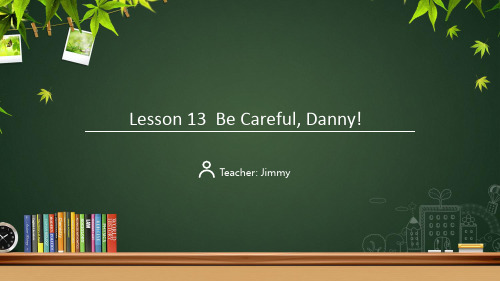
PART TWO
Pre-reading
Pre-reading
safety / ˈseɪftɪ/ n.
安全;平安
Pre-reading
careful / ˈkeəfl / adj.
小心的;仔细的
Pre-reading
Lesson 13 Be Careful, Danny!
Teacher: Jimmy
PART ONE
Warming Up
Warming Up
• Have you ever climbed onto a chair or a desk to reach something? Was it safe?
necessary
hanging
safety serious
P35
PART THREE
While-reading
While-reading P35
While-reading
They were decorating the art classroom.
P35
While-reading
He climbed onto Mr. Jones’ chair.
背诵单词,短语,句子 完成课后练习册
Thanks!
Danny can’t reach the ceiling, so he climbs onto Mr. Jones’ chair.
I tried to catch you, but you landed on top of me.
Shall I call an ambulance?
While-reading
Lesson13教学设计冀教版英语九年级全册
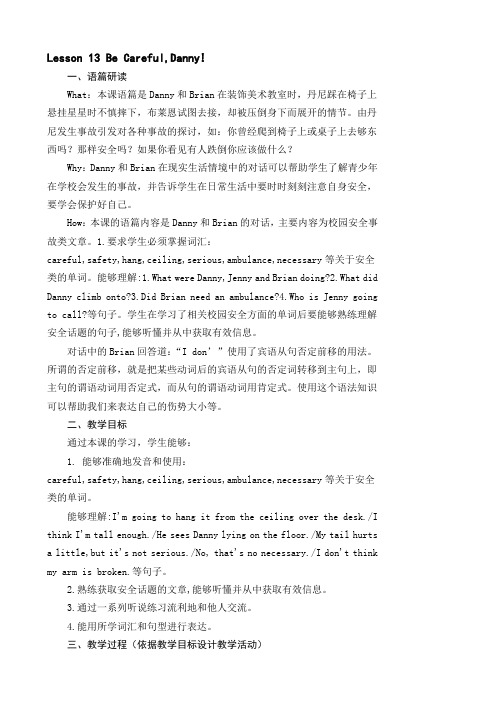
Lesson 13 Be Careful,Danny!一、语篇研读What:本课语篇是Danny和Brian在装饰美术教室时,丹尼踩在椅子上悬挂星星时不慎摔下,布莱恩试图去接,却被压倒身下而展开的情节。
由丹尼发生事故引发对各种事故的探讨,如:你曾经爬到椅子上或桌子上去够东西吗?那样安全吗?如果你看见有人跌倒你应该做什么?Why:Danny和Brian在现实生活情境中的对话可以帮助学生了解青少年在学校会发生的事故,并告诉学生在日常生活中要时时刻刻注意自身安全,要学会保护好自己。
How:本课的语篇内容是Danny和Brian的对话,主要内容为校园安全事故类文章。
1.要求学生必须掌握词汇:careful,safety,hang,ceiling,serious,ambulance,necessary等关于安全类的单词。
能够理解:1.What were Danny,Jenny and Brian doing?2.What did Danny climb onto?3.Did Brian need an ambulance?4.Who is Jenny going to call?等句子。
学生在学习了相关校园安全方面的单词后要能够熟练理解安全话题的句子,能够听懂并从中获取有效信息。
对话中的Brian回答道:“I don’”使用了宾语从句否定前移的用法。
所谓的否定前移,就是把某些动词后的宾语从句的否定词转移到主句上,即主句的谓语动词用否定式,而从句的谓语动词用肯定式。
使用这个语法知识可以帮助我们来表达自己的伤势大小等。
二、教学目标通过本课的学习,学生能够:1.能够准确地发音和使用:careful,safety,hang,ceiling,serious,ambulance,necessary等关于安全类的单词。
能够理解:I'm going to hang it from the ceiling over the desk./I think I'm tall enough./He sees Danny lying on the floor./My tail hurts a little,but it's not serious./No, that's no necessary./I don't think my arm is broken.等句子。
冀教版英语九年级下册Unit3Lesson13BeCareful,Danny教学设计
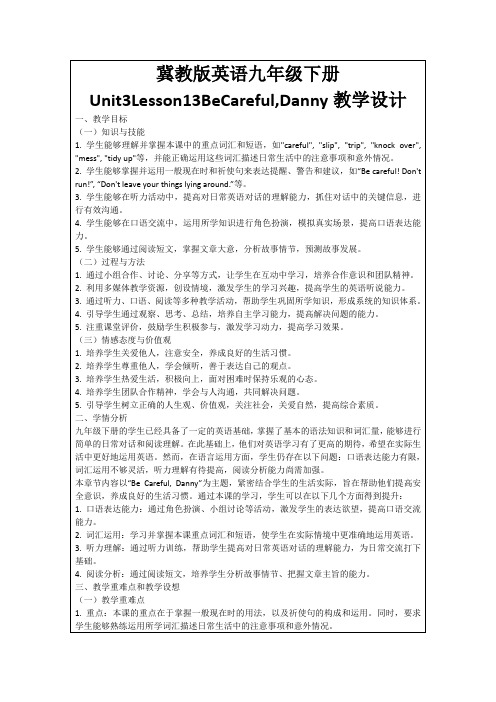
1.教学活动设计:教师将学生分成小组,每组根据教材中的对话场景,进行角色扮演。
2.讨论主题:小组成员讨论如何用英语提醒、警告和建议注意安全事项。
3.教师指导:教师巡回指导,关注学生的发音、语调和对话内容,给予及时反馈。
4.小组展示:各小组轮流展示讨论成果,其他同学给予评价和建议。
5.课后作业:布置与课堂内容相关的作业,如听力练习、口语对话、阅读分析等,帮助学生巩固所学知识。
五、作业布置
为了巩固本节课的学习成果,特布置以下作业:
1.听力练习:请学生完成教材中与本课相关的听力练习,要求学生在听懂对话的基础上,准确回答问题,提高对日常英语对话的理解能力。
2.口语练习:学生以小组为单位,录制一段关于提醒、警告和建议注意安全事项的英语对话。要求每个成员都参与其中,对话内容要包含本节课所学的重点词汇和祈使句型。
3.课堂活动:分组进行角色扮演,模拟对话场景,巩固所学知识。同时,设计小组竞赛,提高学生的参与度。
4.口语练习:设置真实生活场景,让学生运用所学知识进行口语表达,关注发音、流利度和语调。
5.阅读理解:引导学生阅读短文,通过问题讨论、总结提炼,提高阅读分析能力。
6.课堂小结:对本节课的重点知识进行总结,巩固学生的学习成果。
4.引导学生通过观察、思考、总结,培养自主学习能力,提高解决问题的能力。
5.注重课堂评价,鼓励学生积极参与,激发学习动力,提高学习效果。
(三)情感态度与价值观
1.培养学生关爱他人,注意安全,养成良好的生活习惯。
2.培养学生尊重他人,学会倾听,善于表达自己的观点。
3.培养学生热爱生活,积极向上,面对困难时保持乐观的心态。
3.阅读分析:请学生阅读教材中的短文,分析故事情节,总结文章主旨。并在此基础上,回答相关问题,锻炼阅读分析能力。
九下英语第十三课课堂笔记
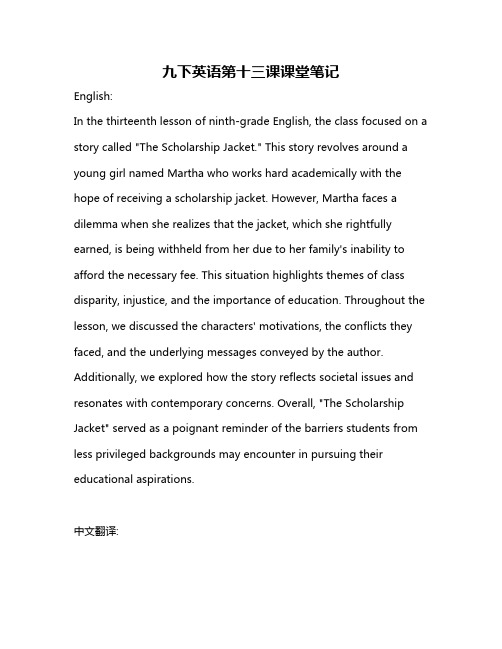
九下英语第十三课课堂笔记English:In the thirteenth lesson of ninth-grade English, the class focused on a story called "The Scholarship Jacket." This story revolves around a young girl named Martha who works hard academically with the hope of receiving a scholarship jacket. However, Martha faces a dilemma when she realizes that the jacket, which she rightfully earned, is being withheld from her due to her family's inability to afford the necessary fee. This situation highlights themes of class disparity, injustice, and the importance of education. Throughout the lesson, we discussed the characters' motivations, the conflicts they faced, and the underlying messages conveyed by the author. Additionally, we explored how the story reflects societal issues and resonates with contemporary concerns. Overall, "The Scholarship Jacket" served as a poignant reminder of the barriers students from less privileged backgrounds may encounter in pursuing their educational aspirations.中文翻译:九年级英语的第十三课聚焦于一则名为《奖学金夹克》的故事。
九年级下册unit3Lesson13Be Careful, Danny!!教学设计模板

Danny fall on him.
Step 6 Reading:
1) Read the lesson and answer the questions.
1.What were Danny, Jenny and Brian doing?
2>.be careful
3.I’m going to hang it from the ceiling over the desk.
hang- hung-hung vi悬挂,垂下
1>.hang up把……挂起来(动副结构)
2>.hang out闲逛
Eg:Please hang up the map on the wall.
讲授新课
Step 3 Warming-up:
Step 4 Free- talk:
1.Watch some pictures about safety. And talk about it in pairs.
Step 5 Listening
Listen to the tape and Answer the questions.
They were decorating the art classroom.
2.What did Danny climb onto?
He climbed onto Mr.Jones' chair.
3.Did Brian need an ambulance?
No, he didn't
4.Who is Jenny going to call?
The children is hanging out in the field.
九年级英语下册Unit13单元知识点
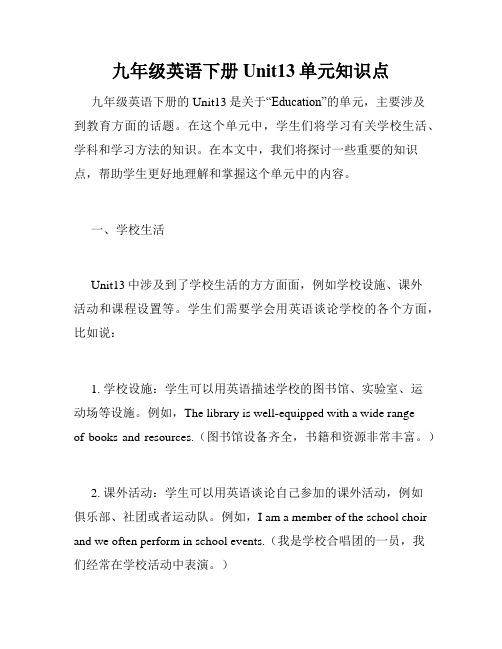
九年级英语下册Unit13单元知识点九年级英语下册的Unit13是关于“Education”的单元,主要涉及到教育方面的话题。
在这个单元中,学生们将学习有关学校生活、学科和学习方法的知识。
在本文中,我们将探讨一些重要的知识点,帮助学生更好地理解和掌握这个单元中的内容。
一、学校生活Unit13中涉及到了学校生活的方方面面,例如学校设施、课外活动和课程设置等。
学生们需要学会用英语谈论学校的各个方面,比如说:1. 学校设施:学生可以用英语描述学校的图书馆、实验室、运动场等设施。
例如,The library is well-equipped with a wide rangeof books and resources.(图书馆设备齐全,书籍和资源非常丰富。
)2. 课外活动:学生可以用英语谈论自己参加的课外活动,例如俱乐部、社团或者运动队。
例如,I am a member of the school choir and we often perform in school events.(我是学校合唱团的一员,我们经常在学校活动中表演。
)3. 课程设置:学生可以用英语介绍自己的课程设置,包括学习科目和上课时间等。
例如,In our school, we have English, math, science, history, and PE. Classes start at 8:30 in the morning and end at 4:00 in the afternoon.(我们学校有英语、数学、科学、历史和体育等科目。
上午8:30开始上课,下午4:00结束。
)二、学科与学习方法除了学校生活,Unit13也涵盖了学科和学习方法的知识。
学生们需要掌握如何用英语讨论各个学科的特点和学习方法。
1. 语言学科:语言学科在学习英语的过程中起着重要的作用。
学生们可以用英语阐述学习英语的好处以及一些学习英语的技巧。
九年级下册unit13知识点
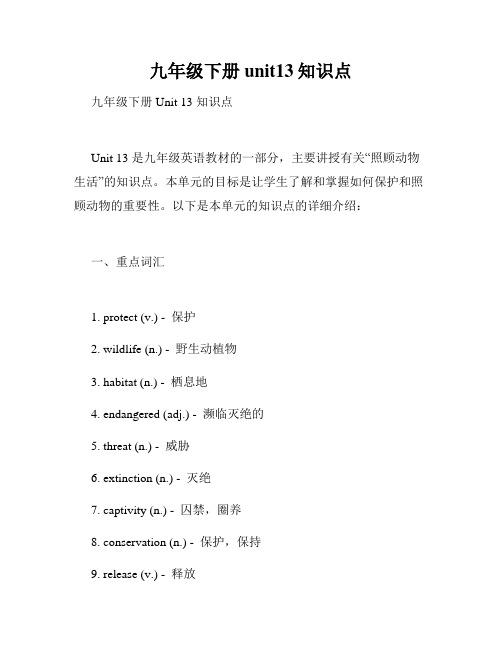
九年级下册unit13知识点九年级下册 Unit 13 知识点Unit 13 是九年级英语教材的一部分,主要讲授有关“照顾动物生活”的知识点。
本单元的目标是让学生了解和掌握如何保护和照顾动物的重要性。
以下是本单元的知识点的详细介绍:一、重点词汇1. protect (v.) - 保护2. wildlife (n.) - 野生动植物3. habitat (n.) - 栖息地4. endangered (adj.) - 濒临灭绝的5. threat (n.) - 威胁6. extinction (n.) - 灭绝7. captivity (n.) - 囚禁,圈养8. conservation (n.) - 保护,保持9. release (v.) - 释放10. responsibility (n.) - 责任二、重点句型1. We should protect wildlife and their habitats.我们应该保护野生动物及其栖息地。
2. Many species are endangered and face the threat of extinction.许多物种处于濒危状态,并面临着灭绝的威胁。
3. Zoos aim to protect animals by keeping them in captivity.动物园通过圈养动物来保护它们。
4. It is our responsibility to conserve the environment and the animals that live in it.保护环境和其生物是我们的责任。
三、知识要点1. 野生动植物保护的重要性野生动植物是我们生态系统的重要组成部分。
保护野生动植物是保护生态平衡、维护生物多样性以及保持地球生态系统稳定的关键。
我们应该尽最大努力保护野生动植物及其栖息地,避免它们灭绝。
2. 濒危物种和灭绝的威胁许多动物种类正处于濒临灭绝的边缘,主要原因是栖息地的破坏、过度捕猎和污染等人类活动带来的威胁。
九年级下英语 Unit 13 Rainy days make me sad
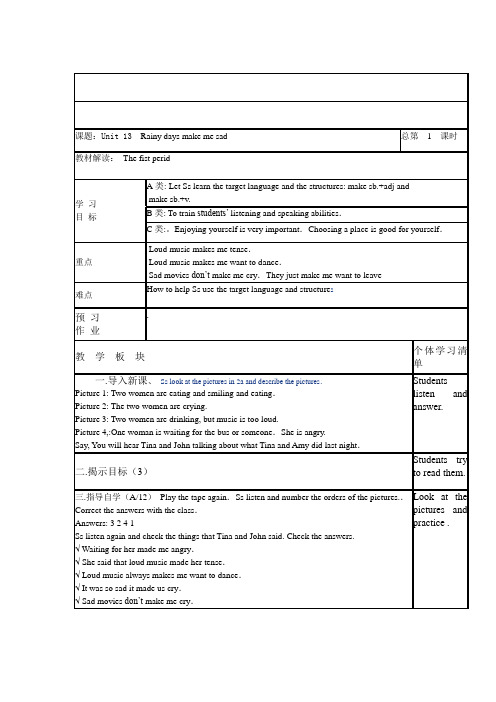
Loud music makes me want to dance .That movie made me sad .教 学 板 块 个体学习清单一.导入新课Listen to a conversation between Amy and Tina talking about eating in restaurants.While listening, pay attention to the “make/s me + infinitive, make/s me + adjective structure” . Students listen and answer.二.揭示目标(3) Students tryto read them.三.指导自学(A/12) On page 102 is a picture of restaurants. Which one would you like to go? And why? ◆I like to go to the one on the left because the music there would make me excited. ◆I like to go to the one on the right because the music there would make me quiet. ◆I like to go to the one on the left because the pictures there would make me tense. ◆ I like to go to the one on the right because the things there would make me happy Look at the pictures and practice .四.点拨、交流与探究 (B C/15) Girl1: I ’m hungry, Amy.Girl2: So am I. Why don ’t we get something to eat?Girl1: Yeah. Let ’s go to the Rockin ’ Restaurant. I love theirhamburgers.Girl2: Oh, Tina … I hate the Rockin ’ Restaurant.Girl1: Why? The food is great, isn ’t it?Girl2: The food ’s fine. I just don ’t like the atmosphere. Those awful pictures on the walls makeme sad, and the loud music makes me tense.Girl1: OK. So where do you want to go, Amy?Girl2: Let ’s go to the Blue Lagoon. The soft music makes me relaxed.Girl1: Not me. It makes me sleepy..五.当堂训练(5)六、课堂小结(2)七、布置作业(1)教学反思:白马初中 九年级 英语 教案备课组成员:尚万斌 韩小霞 任广耀 郑芳芳 备课组长:郑芳芳 主 备 人:尚万斌。
英语九年级冀教版Lesson13BeCarefulDanny
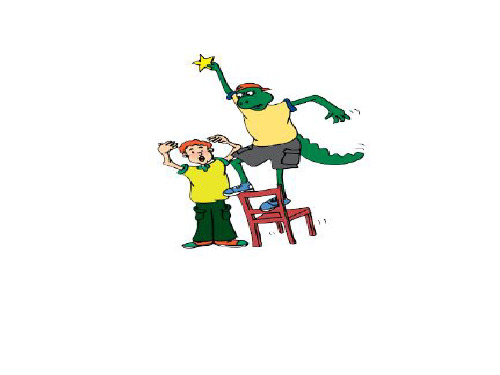
及到,够到”。 ◆onto意为“到……上去”,表示一种动态。 【拓展】 on表示“在……上面”,表示一种静态。
4.Danny falls. fall为动词,意为“落下,跌倒,掉下”,过去式为fell, 过去分词为fallen。 【固定短语】 fall into落入,陷入;fall down跌 倒,摔倒;fall off从……掉下来;fall behind落后于
5.He sees Danny lying on the
floor. see sb. doing sth.意为“看见某人
正在做某事”,see sb. do sth.则意为 “看见某人做了某事”。
【拓展】 和see用法类似的 词还有watch,hear,notice等。
6.Are you hurt? hurt在本句为形容词,意为“疼痛的, 受伤的”。
listen and answer the questions.
1. What were Danny, Jenny and Brian doing? They were decorating the art classroom. 2. What did Danny climb onto? He climbed onto Mr. Jones’ chair. 3. Did Brian need an ambulance? No, he didn’t. 4. Who is Jenny going to call? She is going to call Brian’s mother.
End Ditawnansy’nsotta_il_h__u_r_t _sae. Blriitrotilauens, ’bsut _____hurat,rtmoo.
九年级英语下册unit 13教案
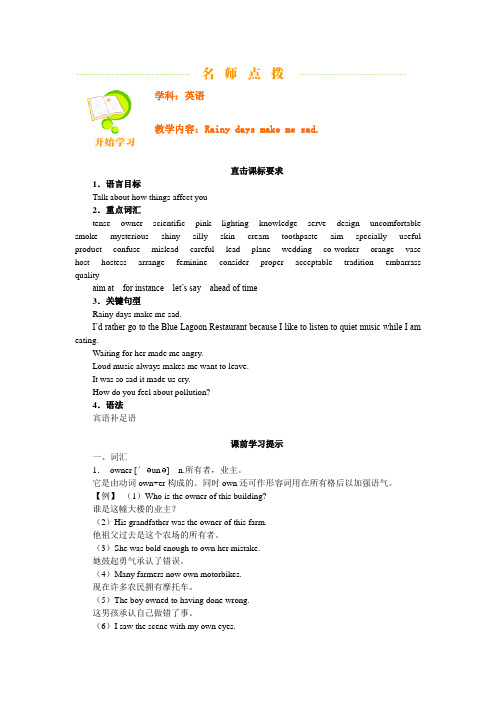
学科:英语教学内容:Rainy days make me sad.直击课标要求1.语言目标Talk about how things affect you2.重点词汇tense owner scientific pink lighting knowledge serve design uncomfortable smoke mysterious shiny silly skin cream toothpaste aim specially useful product confuse mislead careful lead plane wedding co-worker orange vase host hostess arrange feminine consider proper acceptable tradition embarrass qualityaim at for instance let’s say ahead of time3.关键句型Rainy days make me sad.I’d rather go to the Blue Lagoon Restaurant because I like to listen to quiet music while I am eating.Waiting for her made me angry.Loud music always makes me want to leave.It was so sad it made us cry.How do you feel about pollution?4.语法宾语补足语课前学习提示一、词汇1.owner [′un] n.所有者,业主。
它是由动词own+er构成的。
同时own还可作形容词用在所有格后以加强语气。
【例】(1)Who is the owner of this building?谁是这幢大楼的业主?(2)His grandfather was the owner of this farm.他祖父过去是这个农场的所有者。
冀教版九年级英语下册lesson13课件
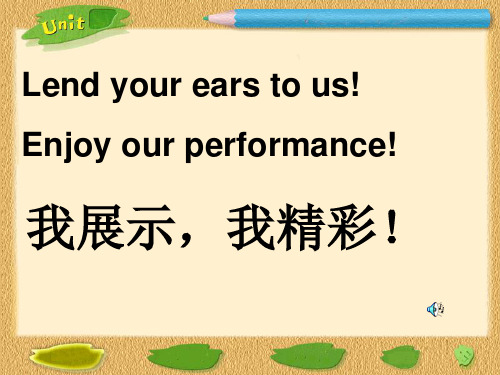
Enjoy our performance!
我展示,我精彩!
They look the same,they are clones.
Lesson 13
Clones Are the Same
一、认 知 学 习 目 标
1.知识目标:
①认读单词laboratory 。 ②掌握并会运用下列短语及句子:hear of=hear about no longer=not...any longer , what if, think of, my own basketball team, ten times, If I were a scientist,I would clone a...,because... 2.能力目标:充分发挥想象力,运用所学知识大胆表述。
③How to expreபைடு நூலகம்s wishes.
Phrases
1. no longer=not ...any longer 不再
2. what if 如果...会怎样? 3. think of 想,认为 4. my own basketball team 我自己的篮球队 5. hear of=hear about 听说,得知
6. ten times 十次
1.独学: 用自己喜欢的方式 独立朗读课文内容,在课 文中勾画出问题答案并标 注出不会翻译的句子。 2.对学:师友交流,学友不会 的地方师傅讲解,最后由学 友展示结果,师傅给予评价。
活动二:Language points
学习步骤及要求(5分钟) 1、独学:自主完成学案“语言点导学”部分。 2、对学:师友互助交流学习结果,并对有分歧的 问题进行标注。 3、群学:小组交流,把不会的地方向组长汇报,组 长做好记录。学友做好展示准备。请学友 展示,师傅补充。
九年级英语下册unit13课件
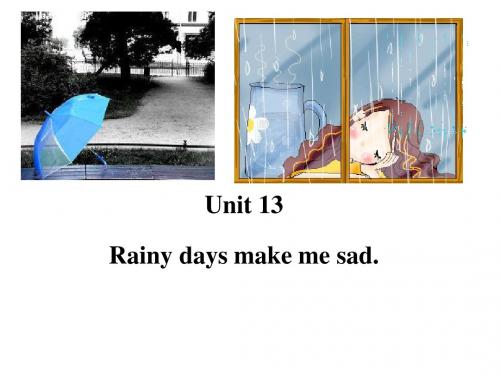
shout 3. The loud music makes me want to _____. laugh 4. He said the sad movie made him _____. dance
Do the exercises:
1. 平缓的音乐让他很放松。 makes him relaxed Peaceful music ______________________. 2. 等她让他很生气。 Waiting for her ____________________. made him angry 3. 这个好消息让我们高兴。 This good news ___________________. made us happy 4. 喜剧片让我大笑。 make me laugh Comedies ___________________. 5. 悲伤的音乐不会让我想哭。 make me want to cry Sad music doesn’t ______________________.
comfortable
哇! sad happy want to cry angry surprised
nervous / tense/ stressed out
excited
annoyed
tired/sleepy
Brainstorm … happy unhappy uncomfortable excited bored nervous Adj. about comfortable feelings(感觉) surprised tense (紧张的,焦虑的) frightened relaxed angry energetic annoyed relaxed sad stressed out
九年级下册英语unit13知识点
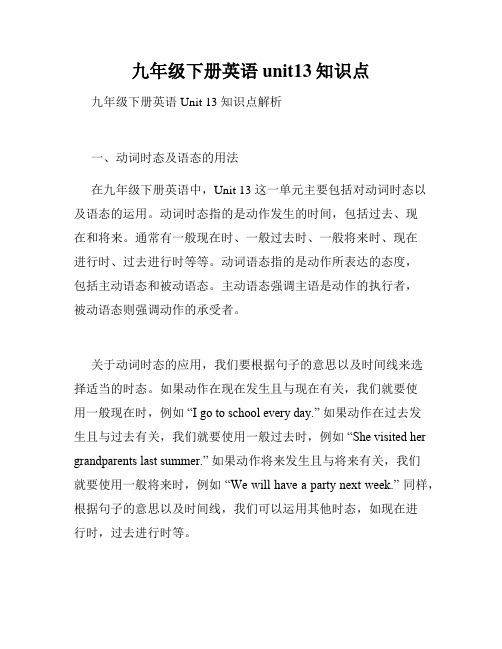
九年级下册英语unit13知识点九年级下册英语 Unit 13 知识点解析一、动词时态及语态的用法在九年级下册英语中,Unit 13 这一单元主要包括对动词时态以及语态的运用。
动词时态指的是动作发生的时间,包括过去、现在和将来。
通常有一般现在时、一般过去时、一般将来时、现在进行时、过去进行时等等。
动词语态指的是动作所表达的态度,包括主动语态和被动语态。
主动语态强调主语是动作的执行者,被动语态则强调动作的承受者。
关于动词时态的应用,我们要根据句子的意思以及时间线来选择适当的时态。
如果动作在现在发生且与现在有关,我们就要使用一般现在时,例如“I go to school every day.” 如果动作在过去发生且与过去有关,我们就要使用一般过去时,例如“She visited her grandparents last summer.” 如果动作将来发生且与将来有关,我们就要使用一般将来时,例如“We will have a party next week.” 同样,根据句子的意思以及时间线,我们可以运用其他时态,如现在进行时,过去进行时等。
在运用动词语态时,需要注意句子的结构和句子中的主语。
如果我们希望强调动作的执行者,我们可以使用主动语态,例如“They clean the classroom every day.” 如果我们希望强调动作的承受者,我们可以使用被动语态,例如“The classroom is cleaned every day by them.” 被动语态的构成为 be 动词 + 动词的过去分词形式。
二、情态动词的用法另一个重要的知识点是情态动词的运用。
在 Unit 13 中,我们接触到的情态动词有 can, could, may, might, will, would, shall, should, must, ought to 等。
情态动词在句子中一般用于表示能力、可能性、许可、推测、义务等。
初三英语下学期lesson-13
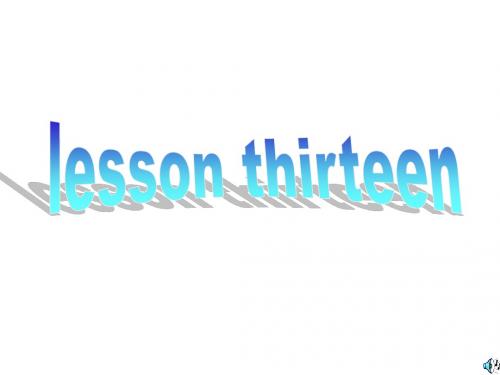
1. Why does Mr. Green want to come to Jim’s school? Beause he wants to tell the school that Jim is going to Mount Emei on Friday
2. Who does Mr. Green want to talk to ? He wants to talk t the headmaster.
The teacher says (that)…… Mr Green says (that)…..
Read the text after the tape, then fill in the blanks.
Homework
1. Homework A 2. Preview Lesson 14.
What does he/she say?
He/ Ihwe a/nsht etoish…av.e an apple.
he / she has gone to ….
She he / she will /won’t …..
says (that)
Ihwe i/lslheeatdaids …mu..ch
as
What does Polly say?
He Ihewwanatntos thoahveavaenaanpapplep.le. says Lucy can’t decide when to come. (that) Li Lei is ill today.
Ihewwillilelaetaat sasmmucuhchasasI hcaenc.an. Mr Green will come between 9 and 12. Ihehahdadananacaccicdiednetnyt eysetsetredradya.y. Ihedodomesy hhiosmheowmoerwkoervkeervyedrayyd. ay. Ihethtihniknkits witilwl ibllebseunsunnyntyomtoomrroorwro.w.
九年级英语下册unit 13英文教案
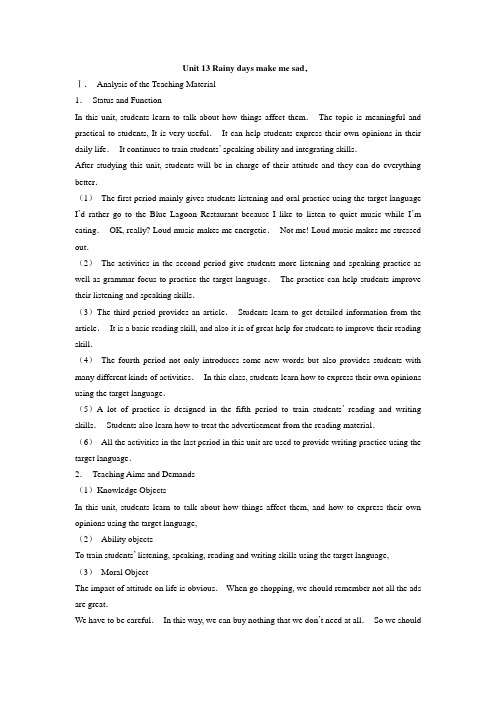
Unit 13 Rainy days make me sad.Ⅰ.Analysis of the Teaching Material1.Status and FunctionIn this unit, students learn to talk about how things affect them.The topic is meaningful and practical to students, It is very useful.It can help students express their own opinions in their daily life.It continues to train students’ speaking ability and integrating skills.After studying this unit, students will be in charge of their attitude and they can do everything better.(1)The first period mainly gives students listening and oral practice using the target language I’d rather go to the Blue Lagoon Restaurant because I like to listen to quiet music while I’m eating.OK, really? Loud music makes me energetic.Not me! Loud music makes me stressed out.(2)The activities in the second period give students more listening and speaking practice as well as grammar focus to practise the target language.The practice can help students improve their listening and speaking skills.(3)The third period provides an article.Students learn to get detailed information from the article.It is a basic reading skill, and also it is of great help for students to improve their reading skill.(4)The fourth period not only introduces some new words but also provides students with many different kinds of activities.In this class, students learn how to express their own opinions using the target language.(5)A lot of practice is designed in the fifth period to train students’reading and writing skills.Students also learn how to treat the advertisement from the reading material.(6)All the activities in the last period in this unit are used to provide writing practice using the target language.2.Teaching Aims and Demands(1)Knowledge ObjectsIn this unit, students learn to talk about how things affect them, and how to express their own opinions using the target language,(2)Ability objectsTo train students’ listening, speaking, reading and writing skills using the target language,(3)Moral ObjectThe impact of attitude on life is obvious.When go shopping, we should remember not all the ads are great.We have to be careful.In this way, we can buy nothing that we don’t need at all.So we shouldbe in charge of our attitude.That way, we can live happily and we can do everything better.3.Teaching Key PointTo make students learn and master the key vocabulary words and the target language.4.Teaching Difficult PointsTo train students’ listening, speaking, reading and writing skills.To train students’ communicative competence.5.Studying WayTeach students how to express their own opinions freely.Ⅱ.Language FunctionTalk about how things affect you.Ⅲ.Target LanguageI’d rather go to the Blue Lagoon Restaurant because I like to listen to quiet music while I’m eating.Oh, really? Loud music makes me energetic.Not me! Loud music makes me stressed out.Ⅳ.StructureSecond conditional with wishⅤ.V ocabularylighting, mysterious, tense, silky, owner, product, knowledge, for instance, shiny,skin, cream, toothpaste, endangered, uncomfortable, usefulⅥ.Recyclingfast food, make, cry, customer, happy, dance, sad, restaurant, red, pink, blue, relaxed, stressed out, awful, soft, energetic, keep outⅦ.Learning Strategies1.Personalizing2.MatchingⅧ.Teaching TimeSeven periodsThe First PeriodⅠ.Teaching Aims and Demands1.Knowledge Objects(1)Key Vocabularysad, energetic, stressed out, soft(2)Target LanguageI’d rather go to the Blue Lagoon Restaurant because I like to listen to quiet music while I’m eating.Oh, really? Loud music makes me energetic.Not me! Loud music makes me stressed out.2.Ability Objects(1)Improve students’ listening ability.(2)Help students to express their opinion freely.3.Moral objectsIt is important to choose a suitable place.It is good for your study and life.Ⅱ.Teaching Key PointTarget LanguageⅢ.Teaching Difficult Points1.How to improve students’ listening ability.2.How to help students to express their opinion freely.Ⅳ.Teaching Methods1.Listening-and-answering activity to help the students go through with the listening material.2.Pairwork to make every student work in class.Ⅴ.Teaching Aids1.A tape recorder2.The blackboardⅥ.Teaching ProceduresStep ⅠRevisionT: Yesterday we finished Unit 12.In this unit, we learned how to tell what we are supposed to do.Now tell me some things that are good to do in school and that are not good to do in school.S1: We’re supposed to do our homework every day.S2: We’re supposed to raise our hands before we talk.S3: We’re supposed to come to class on time.S4: We are not supposed to be late for class.S5: We’re not supposed to eat in class.T: Very good.You’re right.From now on, we’ll learn Unit 13.Look at the following list of activities on the blackboard: parties, exams, school vacations, gym class.How do you feel about parties? Happy?Excited? Nervous?S1: Nervous.T: Oh, so parties make you nervous.S1: Yes.T: Class repeat.Parties make me nervous.S s: Parties make me nervous.T: Now what about school vacations?How do you feel about them?S2: Happy.T: So, school vacations make you happy.S2: Yes.T: Class repeat.School vacations make me happy.S s: School vacations make me happy.T: Now what about gym class? How do you feel about it?S3: Excited.T: So gym class makes you excited.S3: Yes.StepⅡ1aThis activity introduces new vocabulary and provides oral practice using the target language.Go through the instructions and look at the two pictures.Ask, Who can describe the interior of each restaurant? (Rockin Restaurant has red walls, ugly paintings on the walls, and loud music.The Blue Lagoon has blue walls, plants, flowers, and a piano player.)Say, Which restaurant would you rather go to? Talk about it with your parter.Let students work in pairs, and tell each other which restaurant they would like to go to and why.When students work, go around the classroom offering help as needed.When they have finished talking to each other, call out several pairs to say their conversations to the class.Sample conversationS A: Which restaurant would you like to go to?S B: I’d like to go to the Blue Lagoon.S A: Why?S B: Because there are plants and flowers there.Step Ⅲ1bThis activity gives students practice in understanding the target language in spoken conversation.Ask students to read the instructions.Look at the chart and point out the two headings: The Rockin’Restaurant and The Blue Lagoon.Look at the sample answer.Let a student read the completed sentence, and then say, You will hear the missing words on the recording.Fill in the blanks with the words you hear on the tape.Play the recording the first time.Students only listen carefully.Play the recording again.This time fill in the missing words.Check the answers with the whole class.AnswersThe Rockin’ Restaurant: sad, tenseThe Blue Lagoon: relaxed, sleepyTapescriptGirl 1: I’m hungry, Amy.Girl 2: So am I.Why don’t we get something to eat?Girl 1: Yeah.Let’s go to the Rockin’ Restaurant.I love their hamburgers.Girl 2: Oh, Tina…I hate the Rockin’ Restaurant.Girl 1: Why? The food is great, isn’t it?Girl 2: The food’s fine.I just don’t like the atmosphere.Those awful pictures on the walls make me sad, and the loud music makes me tease.Girl 1 :OK.So where do you want to go, Amy?Girl 2: Let’s go to the Blue Lagoon.The soft music makes me relaxed.Girl 1: Not me.It makes me sleepy.Step Ⅳ1cThis activity provides guided oral practice using the target language.Look at the example in the box.Invite a pair of students to read it to the class.S A: I’d rather go to the Blue Lagoon Restaurant because I like to listen to quiet music while I’m eating.S B: Oh, really? Loud music makes me energetic.S A: Not me! Loud music makes me stressed out.Go through the instructions with the class.Tell students they will be talking about their own opinions with a partner.Look back at the chart in Activity 16.Make up a conversation with a partner using words from the chart, such as awful pictures, loud music and soft music.While students are working in pairs, walk around the classroom, and listen to some pairs.If necessary, offer language support.Then ask some pairs to act out their conversations in front of the whole class.Optional activityLet students look around the classroom, think about other rooms in the school, and talk about how these places make the students feel.For example, what are your opinions about this room? A student might answer, This room is sunny.It makes me happy.Or ask them.What are youropinions about all the noise in the cafeteria? A student might say.All the noise in the cafeteria makes me tense.Notes:1.awful——terrible; dreadful2.energetic——full of energyStep ⅤSummaryIn this class, we’ve learned some important words, such as sad, energetic, stressed out.We’ve also learned the target language I’d rather go to the Blue Lagoon Restaurant because I like to listen to quiet music while I’m eating.Oh, really?Loud music makes me energetic.Not me!Loud music makes me stressed out.Step ⅥHomeworkReview the target language.Step ⅦBlackboard DesignUnit 13 Rainy days make me sad.The Second PeriodⅠ.Teaching Aims and Demands1.Knowledge Objects(1)Key Vocabularytense, have fun, angry, cry.(2)Target LanguageLoud music makes me tense.Loud music makes me want to dance.That movie made me sad.2.Ability Objects(1)Train students’ listening ability.(2)Train students’ speaking ability.3.Moral ObjectsEnjoying yourself is very important.But no matter what hobbies you have, do remember they must be good for health and study.Ⅱ.Teaching Key Points1.Key Vocabularytense, angry, cry.2.Target LanguageLoud music makes me tense.Loud music makes me want to dance.That movie made me sad.3.StructuresLoud music makes me tense.Loud music makes me want to dance.Ⅲ.Teaching Difficult Points1.The target language2.How to train students’ listening ability.Ⅳ.Teaching Methods1.Listening method to improve the students’ listening ability.2.Pairwork.Ⅴ.Teaching AidA tape recorderⅥ.Teaching ProceduresStep ⅠRevisionCheck homework.Invite a pair of students to read the conversation in Activity 1c.Then let some pairs act out their conversations according to the pictures in Activity 1a and Activity 1c.S A: I’d rather go to the Rockin’ Restaurant because I like to listen to loud music while I’m eating.S B: Really? Soft music makes me relaxed.S A: Not me.Soft music makes me sleepy.Step Ⅱ2aThis activity gives students practice in understanding the target language in spoken conversation.Look at the pictures.Ask, What are they doing? Please guess.(In Picture 1, two women are eating and smiling.Maybe the food is very delicious.In Picture 2, the two women are crying.Maybe they are seeing a sad movie.In Picture 3, one of the two women is very tensethat because of the loud music.In Picture 4, one woman is waiting for the bus or someone.Waiting makes her angry.)Go through the instructions with the class.Say, You will hear Tina and John talking about what Tina and Amy did last night.The four pictures show something that Tina did last night.Point to the boxes.Say, Use the number 1 through 4 to show the order you hear Tina and John talk about these things in the recording.Play the tape for students.The first time, students just listen.Play the tape again.This time, ask students to number the pictures when they listen.Correct the answers with the class.AnswersThe pictures should be numbered in this order: (down)3 24 1TapescriptBoy: Did you and Amy have fun last night, Tina?Girl: Well, John…yes and no.Boy: Was Amy late as usual.Girl: Yes, she was.And waiting for her made me angry.Boy: Where did you go?Girl: First we went to the Rockin’ Restaurant, but Amy didn’t want to stay.She said that loud music made her tense.Boy: That’s funny.Loud music always makes me want to dance.Girl: Me too.So then we went to the BlueLagoon.It was quiet and the food was great.We had a good time.Boy: Then did you go to the concert at the high school?Girl: No.We decided to go to the movies.We saw Love Me Forever.It was a really good movie, but it was so sad that it made us cry.Boy: Sad movies don’t make me cry.They just make me want to leave!Girl: You should just like my brother!Step Ⅲ2bThis activity provides guided listening practice using the target language.Go through the instructions and point to the list of statements.You will hear the same recording again.This time listen carefully to what each person says.Put a checkmark in front of the statements you hear.Look at the sample answer.On.the tape Tina says, Waiting for her made me angry, so acheckmark goes in front of this sentence.Play the tape again.Let students check the sentences they hear.Ask students to say the reasons why they check them.Check the answers with the class.Answers√Waiting for her made me angry.√She said that loud music made her tense.Loud music makes me happy.√Loud music always makes me want to dance.√It was so sad it made us cry.√Sad movies don’t make me cry.They just make me want to leave!It made me sad.StepⅣ2cThis activity provides oral practice using the target language.Look at the sample conversation betweenTina and John.Invite a pair of students to read it to the class.John: Did you have fun with Amy last night?Tina: Well…yes and no.She was really late.Go through the instructions with the class.Get students to make up a conversation using information from Activities 2a and 2b.Let students work in pairs.While they are working, go around the classroom checking the progress of the pairs and offering help as necessary.Call out a pair of students to say their conversation to the class.S A: Did you have fun with Li Ping last night?S B: Well…yes and no.She was late again as usual.S A: So, waiting for her made you angry.Where did you go?S B: We went to a small restaurant.It was quiet and clean.The food was delicious.The soft music made me very happy.S A: Did you go to see a movie?S B: Yes.We saw Love Me Once More,Mother.It was a very good movie.It was also moving and sad.It made us cry.S A: Really? You sound just like my mother.Step ⅤGrammar FocusLook at the grammar box.Invite a student to read the sentences to the class.Loud music makes me tense.Loud music makes me want to dance.That movie made me sad.While the student is reading, write the three sentences on the blackboard.Then ask, What verb do you see in all three sentences in the Grammar Focus? (make in the present and in the past tense)Let students underline the verb in all three sentences.Then underline the word that comes right after that verb (me).Ask, What does this word tell us? (It tells who had the feeling-me, her, etc.)Circle the ending of each sentence.Get a student to come to the blackboard and point to the circled words that are adjectives and read these words to the class (tense, sad).Other students repeat.Then let students make up similar sentences with the verb make that talk about feelings and have adjective at the end.Write on the blackboard:makes me .Let students work alone.Then ask some students to read their sentences.S1: A quiet place makes me sleepy.S2: Loud noise makes me tense.Pay attention to the sentence with wanting to dance at the end.Say, Sometimes there is a phrase like want to dance at the end instead of an adjective.For example,Loud music makes me want to leave, Ask students to make up sentences with the following sentence starters: Long movies make me .Hot weather makes me .Give students two minutes to finish the sentences.Then ask some students to read their sentences.S1: Long movies make me want to leave.S2: Long movies make me want to cry.S3: Hot weather makes me want to go swimming.S4: Hot weather makes me want to drink a lot of water.Let students make up any other sentence using the verb make to talk about how things affect them.StepⅥSummaryIn this class, we’ve learned key vocabulary tense and the target language Loud music makes me tense.Loud music makes me want to dance.That movie made me sad.Step ⅦHomeworkGet students to write some sentences according to the target language.Step ⅧBlackboard DesignUnit 13 Rainy days make me sad.The Third Period Ⅰ.Teaching Aims and Demands1.Knowledge Objects(1)Key Vocabularyowner, scientific, pink, knowledge, serve, uncomfortable, endangered.(2)Target LanguageHow do you feel about pollution?It makes me kind of angry.How about you?It makes me want to join a clean-up campaign.2.Ability Objects(1)Train students’ integrating skills.(2)Train the ability of expressing students’ own opinions.3.Moral ObjectIn our lives, we should express what we feel clearly.Ⅱ.Teaching Key PointTrain students’ integrating skills.Ⅲ.Teaching Difficult PointHow to improve students’ integrating skills.Ⅳ.Teaching Methods1.Fast-reading method.2.Groupwork and pairwork.Ⅴ.Teaching Aids1.A projector.2.The blackboard.Ⅵ.Teaching ProceduresStep ⅠRevisionT: Yesterday we learned the target language.The structure is…makes me…Now who can make sentences using the structure?S1: Light colours make me relaxed.S2: Loud noise makes me tense.S3: Loud music makes me energetic.T: Very good.Step Ⅱ3aThis activity provides reading and writing practice using the target language.Show the key vocabulary words on the screen by a projector.Read the words and get students to repeat again and again until they can pronounce the words fluently and accurately.Point to the picture and ask, What can you see in the picture? Ask some students to describe the picture.Offer help if necessary.(The walls are bright red.There is loud music.There are bright lights in the ceiling.The people are eating quickly.They aren’t talking to each other.)Read the instructions and the questions below the article aloud.Make sure students understand what to do.Read the title“Restaurant Science”and ask, What do you think “Restaurant Science”means? (It means the study of how to operate a restaurant.)Get students to read the article on their own.Let students underline any words or phrases they don’t understand.Go through each word or phrase and ask some students to explain what they think it means.Be sure students know what the article is about.Ask students to read the articlealone again and answer the questions.Have students work individually.Ask three students to answer the questions orally in class.Correct the answers if necessary.Check the answers with the whole class.Answers1.Red makes most people hungry.It makes them eat faster.2.They want people to eat quickly and leave so more people can come in.3.Answers will vary.Notes1.owner—person who owns something2.uncomfortable—not comfortable; uneasyStep Ⅲ3bThis activity provides oral practice using the target language.Ask three students to read the sample conversation in the box to the whole class.S A: The seats are very hard.The white walls make me stressed.S B: Is it this classroom?S A: No, it isn’t.S C: Is it a hospital?S A: Yes, that’s right.Go through the instructions with the class.Say, First take a few minutes to think of a place and how you will describe it.You can write down some words that describe the place.Get student to work in groups of four or five.Each students describes a place and others in the group try to guess it.While students are doing their work, walk around the classroom checking their progress and offering help if necessary.At the end of the groupwork, have some students say their descriptions to the class and see how quickly the other students can guess what the place is.Give students a sample conversation.S A: There are a lot of people every day.The loud noise makes me tense.S B: Is it a mall?S A: No, it isn’t.S C: Is it a supermarket?S A: No, it isn’t.S D: Is it a market?S A: Yes, you’re right.Step IV Part 4This activity provides reading, writing, listening and speaking practice using the target language.Ask a good student to tell students how he/she feels about pollution.For example, I hate pollution.Loud noise makes me tense.Smoking makes me very angry.Endangered animals make me sad.I think pollution is very terrible.Get students to read the instructions by themselves.Have students complete the work in groups of three.As they work, go around the classroom offering help as needed.Review the task.Ask a few students to share the results of their surveys.Sample answersStep ⅤSummaryIn this class, we’ve learned some key vocabulary words such as owner, scientific, knowledge, uncomfortable.We’ve also done a lot of reading, writing and speaking practice using the target language.Step ⅥHomework1.Finish off the exercises on pages 53~55 of the workbook.2.Ask students to choose some places they know and talk about how they feel about the places.Step ⅦBlackboard DesignUnit 13 Rainy days make me sad.The Fourth PeriodⅠ.Teaching Aims and Demands1.Knowledge Objects(1)Key Vocabularymysterious, shiny, silky, skin, cream, toothpaste, keep out(2)Target LanguageHave you ever had a Twisty Treat?Yeah.And it made me sick.2.Ability Objects(1)Train students’ speaking and listening ability.(2)Train students’ ability to understand the target language in spoken conversation.(3)Train students’ ability to use the target language.3.Moral ObjectNot all the most expensive things are the best ones.Sometimes we shouldn’t believe all of ads.Ⅱ.Teaching Key Points1.Key Vocabularymysterious, shiny, silky, skin, keep out2.Target LanguageHave you ever had a Twisty Treat?Yeah.And it made me sick.Ⅲ.Teaching Difficult Points1.How to train students’ speaking and listening ability.2.How to use the target language.Ⅳ.Teaching Methods1.Listening method2.Groupwork to make every student works in class.Ⅴ.Teaching Aids1.A tape recorder2.The blackboardⅥ.Teaching ProceduresStep ⅠRevisionCheck homework.Get some pairs to act out their conversations about how they feel about a place, Collect their conversations and help students correct any mistakes.Step Ⅱ1aThis activity introduces new vocabulary.Pay attention to the four pictures.Ask,Who can tell me what each thing is? Get a student to answer.Repeat the name of each productand let the class repeat (soap, shampoo, toothpaste, and sunglasses).Look at the four slogans.Have a student read each one to the class and make sure students can guess what it means.If the students can’t guess, explain the meaning to them.(Whiter than white means that something has a very, very white color.If a person has that mysterious look, it means that the person looks interesting and unusual.It’s difficult to know what a mysterious person is thinking.The shiniest hair means that the person’s hair will look very bright and have lots of light in it.silky skin means that the person’s skin is soft and nice to touch.)Go through the instructions with the class.Ask them to write the number of each slogan, with the correct picture.Check the answers with the class.AnswersThe photos should be numbered in the following order:4 3 1 2Notes1.slogan——striking and easily remembered phrase used to advertise sth.2.mysterious--full of mysteryStepⅢ 1 bThis activity helps students apply the ideas in the unit to their lives outside the classroom.Go through the instructions with the class.Make sure students know what to do.Get students to make lists individually.Ask some students to read their lists to the class.Have other students put up their hands if they have the same item on their own lists.Three products students likecomputer (26)jacket (20)watch (35)Three products students don’t likefast food (8)coat (32)science book (23)Step Ⅳ2aThis activity provides listening practice with the target language and introduce new vocabulary.Go through the instructions and make sure students understand what to do.Now you will hear about some more products and what people think of them.Write Yes in front of the product if the person likes it.Write No in front of the product if the person doesn’t like it.Read out the name of each product.Get students to repeat it.Listen to the conversation and finish the task.Play the tape the first time.This time students only listen.Play the tape again.Let students write Yes or No in front of each product to show whether or not the people on the tape liked it.Check the answers.Answers1.No 2.No 3.Yes 4.NoTapescriptGirl 1: Wow! Look at this ad for Easy Care Shampoo.For the shiniest hair ever.Boy: I can’t stand ads like that! They make me really mad.Girl 1: Why?Boy: They make you think that you can look like the person in the ad.But I bought that shampoo and it didn’t work.Girl 2:I agree.Look at this one.Lookout Sunglasses.For that mysterious look.I’ll bet they don’t even keep out the sun.Boy: And what about this one! Beauty Cream--the silky skin soap.Girl 2: Wait a minute! I tried Beauty Cream and it works really well.It makes your skin really seft.Have you ever tried Starshine Toothpaste?Girl 1 :Oh, you mean whiter than white?Yeah, I tried it and it tastes terrible.I’d never use it.Boy: I guess you shouldn’t believe everything you read.Step Ⅴ2bThis activity provides guided listening practice using the target language.Go through the instructions with the whole class.Look back at the two lists in Activity 2a.Get students to put up their hands if they don’t understand ANY of the words.If necessary, explain new vocabulary.Read each item to the class.Look at the sample answer and invite a student to read the matching parts to the class.Easy Care Shampoo--It didn’t work.Tell students how to do the task.Draw a line from each product to the sentence that describes that product.Now, listen to the tape.You will hear the same recording again.This time listen carefully and draw lines to match up items in the two lists.play the recording again.Let students draw lines individually in their books.Check the answers with the class.Answers1.d 2.c 3.b 4.aStep Ⅵ2cThis activity provides guided oral practice using the target language.Read the instructions for this activity aloud to the class.Get students to look back at the list of products they made for Activity lb.Invite a student to read his/her lists to the class.Three products he/she likescomputerjacketwatchThree products he/she doesn’t likefast foodcoatscience bookLook at the example in the box.Let a pair of students read the conversation to the class.S A: Have you ever had a Twisty Treat?S B: Yeah.And it made me sick.Now work with your partner.Make up conversations like this one, using the products on the list you made for Activity 1b.Ask students to work in pairs.While they are working, walk around the classroom offering help as needed.Call out several pairs to give their conversations to the class.Conversation 1S A: Have you ever had a computer?S B: Yeah.And it made me excited.Conversation 2S A: Have you ever eaten fast food?S B: Yeah.And it made me uncomfortable.Step ⅦSummaryIn this class, we’ve learned some key vocabulary, such as mysterious, shiny, silky, skin, keep out.We’ve also learned the target language Have you ever had a Twisty Treat? Yeah.And it made me sick by listening and speaking.Step ⅧHomeworkTalk about some products using some words in this class, and write down the conversations.Step ⅨBlackboard Design。
初三英语下册《Unit13》教案
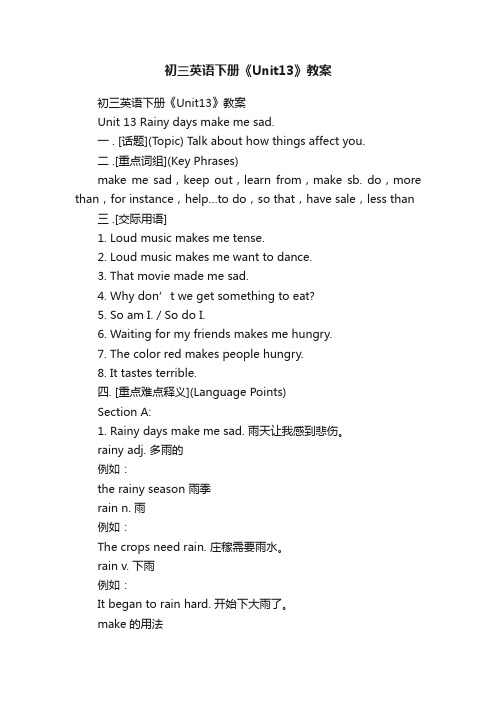
初三英语下册《Unit13》教案初三英语下册《Unit13》教案Unit 13 Rainy days make me sad.一 . [话题](T opic) Talk about how things affect you.二 .[重点词组](Key Phrases)make me sad,keep out,learn from,make sb. do,more than,for instance,help…to do,so that,have sale,less than三 .[交际用语]1. Loud music makes me tense.2. Loud music makes me want to dance.3. That movie made me sad.4. Why don’t we get something to eat?5. So am I. / So do I.6. Waiting for my friends makes me hungry.7. The color red makes people hungry.8. It tastes terrible.四. [重点难点释义](Language Points)Section A:1. Rainy days make me sad. 雨天让我感到悲伤。
rainy adj. 多雨的例如:the rainy season 雨季rain n. 雨例如:The crops need rain. 庄稼需要雨水。
rain v. 下雨例如:It began to rain hard. 开始下大雨了。
make的用法(1) make +n.例如:make food 做饭make a plane 做飞机make the bed 铺床make money 赚钱(2). make sb./sth. + adj. 使某人(感到),使……处于某种状态make的宾语之后可跟名词,形容词,分词来充当宾语的补足语1)名词作make的宾语补足语例如:The party made her a good teacher. 党把她培养成为一名好教师.名词作宾补2)形容词作make的宾语补足语例如:Soccer makes me crazy. 足球使我疯狂。
- 1、下载文档前请自行甄别文档内容的完整性,平台不提供额外的编辑、内容补充、找答案等附加服务。
- 2、"仅部分预览"的文档,不可在线预览部分如存在完整性等问题,可反馈申请退款(可完整预览的文档不适用该条件!)。
- 3、如文档侵犯您的权益,请联系客服反馈,我们会尽快为您处理(人工客服工作时间:9:00-18:30)。
[单选]微粒皮移植最佳供皮区选择是()A.上臂内侧B.胸、背部C.头皮D.腹部E.大腿 [填空题]东方电机厂QFSN—300—2型汽轮发电机油密封箱油位过高()mm、过低()mm报警,密封瓦油压异常过高()MPa、过低()MPa报警,密封瓦回油温度()℃报警。 [填空题]在计算地震作用时,建筑物重力荷载代表值为()之和。 [判断题]如果某档位的动力传动路线上有单向离合器工作,则该档位没有发动机制动。()A.正确B.错误 [单选]发展心理学是研究()的科学。A.认知发展规律B.心理的种族发展C.心理的种系发展D.心理发展规律 [单选]项目管理规划大纲的编制者是()。A.企业管理层B.项目管理层C.企业管理层和项目管理层D.都不是 [单选]质量问题是经济社会发展的()问题,关系可持续发展,关系人民群众切身利益,关系国家形象。A.基本;B.重要;C.战略。 [单选,A2型题,A1/A2型题]若问诊,经期腹痛3天,灼痛拒按,经量多,色紫红,质稠伴血块,小便黄赤,多为()A.气滞血瘀B.湿热蕴结C.寒凝血瘀D.气血虚弱E.肾气亏损 [单选]经济结构和居民成分复杂,有较健全的初级社会服务系统,开始摆脱传统的以家庭为单位的服务方式,逐步建立社会化服务系统。具有以上特征的属于哪种社区类型()A.城市社区B.农村社区C.集镇社区D.海滨社区E.乡镇社区 [单选]化妆品变应性接触性皮炎的发生取决于()。A.化妆品含有的变应原物质和使用者的皮肤状况B.化妆品本身的化学刺激作用和使用者本身的特异体质C.使用者本身的特异体质和皮肤状况D.化妆品含有的变应原物质和使用者本身的特异体质E.化妆品本身的化学刺激作用和使用者的皮肤状况 [单选]丙烯塔回流泵全坏,操作调整中最应该注意()。A、塔顶压力B、塔底液面C、回流罐液面D、塔底温度 [单选,A2型题,A1/A2型题]一般小儿在几岁左右平衡、精细动作、粗大运动的协调发育基本成熟()A.10岁B.11岁C.9岁D.7岁E.4岁 [单选]预防风心病加重的根本措施是().A.积极治疗心力衰竭B.积极锻炼身体C.饮食清淡,避免妊娠D.预防和治疗感染E.卧床休息 [单选]保险营销员向大众发放宣传资料、险种介绍和保险利益表的行为叫()A.要约B.要约邀请C.承诺D.承诺邀请 [单选,A1型题]异质性检验的统计量服从何种分布(k为研究的个数n为第i个研究的样本量)()A.自由度为∑ni-k的卡方分布B.自由度为k-1的卡方分布C.自由度为k-1的F分布D.自由度为∑ni-k的F分布E.自由度为k-1的t分布 [单选]法兰密封件截面尺寸小,质量轻,消耗材料少,且使用简单,安装、拆卸方便,特别是具有良好的密封性能,使用压力可达高压范围,此种密封面形式为()。A.凹凸面型B.榫槽面型C.O型面型D.环连接面型 [填空题]高级优质钢在钢牌号后加字母符号()而特级优质钢则在钢牌号后加字母符号()。 [问答题,简答题]试述机械损失的测定方法。 [单选]将某个证据与本案其他证据联系起来进行综合对比分析,加以认证,这种证据的审查方法是()。A.整合认证法B.资格确认法C.对照分析法D.比较取舍法 [单选]石油的易燃性,可通过其()的高低来判断。A.密度B.闪点、燃点、自燃点C.粘度D.凝固点 [判断题]在概括河流图形时,首先要研究河流的弯曲形状和曲折系数。A.正确B.错误 [判断题]居住在境内的18周岁以下的中国公民实名证件为户口簿。()A.正确B.错误 [单选,A型题]引起术后气性坏疽的梭状芽孢杆菌通常来自:()A.空气B.肠道C.敷料D.手术器械E.输液 [问答题,简答题]什么是全回流? [单选]刚体匀速转动时不在转轴上的各点,不具有()的性质。A.角速度相等B.所转过角度相等C.角加速度为零D.速度相等 [多选]下列关于我国期货交易代码的说法,正确的是()。A.铜合约的交易代码是CUB.黄金合约的交易代码是GC.天然橡胶合约的交易代码是RUD.燃料油合约的交易代码是FU [多选]根据我国《民法通则》以及相关的法律规范的规定,能够引起债的发生的法律事实,即债的发生根据,主要有()。A.不当得利B.无因管理C.合同D.侵权行为E.不可抗力 [单选]旷葡萄糖苷酶抑制剂常见不良反应是()A.低血糖症B.腹胀和腹泻C.下肢浮肿D.乳酸性酸中毒E.充血性心力衰竭 [单选]石灰干燥法主要用于下列哪一类药物的储存()。A.根及根茎类B.果实种子类C.少量贵重药及胶类药D.花类药E.以上均不是 [单选,A2型题,A1/A2型题]根据医院环境的分类,普通病室属()A.Ⅰ类环境B.Ⅱ类环境C.Ⅲ类环境D.Ⅳ类环境E.Ⅴ类环境 [单选,A2型题,A1/A2型题]右心衰竭心功能变化的指标是()ABCDE [单选,A2型题,A1/A2型题]pT0的含义是()A.术前影像证实早期癌B.术前已判定为原位癌C.术后病理检查发现原位癌D.术后组织病理学检查未发现原发肿瘤E.术后病理检查诊断明确分型 [单选,A1型题]下列偏倚不可能在Meta分析过程中产生的是()A.发表偏倚B.奈曼偏倚C.英语偏倚D.文献库偏倚E.多次发表偏倚 [单选,A2型题,A1/A2型题]“以人为本,践行宗旨”的行为规范,主要体现在()A.坚持救死扶伤、防病治病的宗旨B.发扬大医精诚理念和人道主义精神C.以病人为中心,全心全意为人民健康服务D.以上都是E.以上都是 [判断题]使命是一个组织存在的理由或价值。组织的每一个成员都非常清楚这一点,所以没有必要形成文件。()A.正确B.错误 [单选]平行的两根载流导体,在通过同方向的电流时,两导体将()。A.互相吸引B.互相排斥C.没反应D.无法判断 [多选]某大型工程项目进行施工招标,招标人编制了完整。详细的招标文件,内容包括:(1)招标公告;(2)投标须知;(3)通用条件;(4)专用条件;(5)合同格式;(6)图纸;(7)工程量清单;(8)中标通知书;(9)评标委员会名单;(10)投标文件格式等。招标人通过资格预审对申请投标人进行审查,确定了资 [单选]存在明显的对健康有害因素的人群,其发生疾病的概率明显高于其他人群。这类人称为()A.亚健康人群B.病人C.高危人群D.潜伏期病人E.重点保健人群 [单选]重复电刺激前,通常停用抗胆碱酯酶药()A.2~4小时B.4~8小时C.8~12小时D.12~18小时E.无要求 [问答题,简答题]求以下表达式的值,写出您想到的一种或几种实现方法:1-2+3-4+……+m
